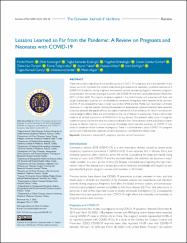| dc.contributor.author | Marim, Feride | |
| dc.contributor.author | Karadoğan, Dilek | |
| dc.contributor.author | Eyüboğlu, Tuğba Şişmanlar | |
| dc.contributor.author | Emiralioğlu, Nagehan | |
| dc.contributor.author | Gürkan, Canan Gündüz | |
| dc.contributor.author | Töreyin, Zehra Nur | |
| dc.contributor.author | Akyıl, Fatma Tokgöz | |
| dc.contributor.author | Yüksel, Aycan | |
| dc.contributor.author | Arıkan, Hüseyin | |
| dc.contributor.author | Şerifoğlu, İrem | |
| dc.contributor.author | Gürsoy, Tuğba, Ramaslı | |
| dc.contributor.author | Sandal, Abdulsamet | |
| dc.contributor.author | Akgün, Metin | |
| dc.date.accessioned | 2020-12-19T20:44:28Z | |
| dc.date.available | 2020-12-19T20:44:28Z | |
| dc.date.issued | 2020 | |
| dc.identifier.citation | Marim, F., Karadoğan, D., Eyüboğlu, T.S., Emiralioğlu, N., Gürkan, C.G. ve diğerleri. (2020). Lessons learned so far from the pandemic: a review on pregnants and neonates with COVID-19. Eurasian Journal of Medicine, 52(2), 202-210. | |
| dc.identifier.issn | 1308-8734 | |
| dc.identifier.issn | 1308-8742 | |
| dc.identifier.uri | https://doi.org/10.5152/eurasianjmed.2020.20118 | |
| dc.identifier.uri | https://app.trdizin.gov.tr/makale/TXpnek1EZzRPQT09 | |
| dc.identifier.uri | https://hdl.handle.net/11436/5998 | |
| dc.description.abstract | There are concerns regarding the risk and the course of COVID-19 in pregnancy and in the neonates. In this review, we aimed to present the current understanding of severe acute respiratory syndrome coronavirus 2 (SARS-CoV-2) infection during pregnancy and neonatal periods considering diagnosis, treatment, prognosis, and prevention. Few studies on pregnant women with COVID-19 have been conducted between December 2019 and April 2020. The majority of patients applied in the third trimester and presented with fever and cough. Ground-glass opacities and consolidation on computed tomography were reported to be common. COVID-19 was proposed to have a milder course than SARS and the Middle East respiratory syndrome coronavirus in pregnant women. Hydroxychloroquine and antiproteases (lopinavir/ritonavir) were reported to be safe; however, therapeutic efficacy and safety of remdesivir still lack evidence. As ribavirin and favipiravir have teratogenic effects, there are some debates on the use of ribavirin in severe cases. There is still no clear evidence of vertical transmission of SARS-CoV-2 during delivery. Occupational safety issues of pregnant healthcare workers on the frontline should be considered as their risk to develop severe pneumonia is higher because of altered maternal immune response. Knowledge about neonatal outcomes of COVID-19 was based on studies of the last trimester of pregnancy. There is much to be learnt about COVID-19 in pregnant women and in the neonates, especially concerning prognosis- and treatment-related issues. | en_US |
| dc.language.iso | eng | en_US |
| dc.rights | info:eu-repo/semantics/openAccess | en_US |
| dc.subject | Coronavirus Disease 2019 | en_US |
| dc.subject | Pregnancy | en_US |
| dc.subject | Neonate | en_US |
| dc.subject | Vertical Transmission | en_US |
| dc.subject | Respiratory-Syndrome | en_US |
| dc.subject | Outcomes | en_US |
| dc.subject | Virus | en_US |
| dc.subject | Women | en_US |
| dc.title | Lessons learned so far from the pandemic: a review on pregnants and neonates with COVID-19 | en_US |
| dc.type | article | en_US |
| dc.contributor.department | RTEÜ, Tıp Fakültesi, Dahili Tıp Bilimleri Bölümü | en_US |
| dc.contributor.institutionauthor | Karadoğan, Dilek | |
| dc.identifier.doi | 10.5152/eurasianjmed.2020.20118 | |
| dc.identifier.volume | 52 | en_US |
| dc.identifier.issue | 2 | en_US |
| dc.identifier.startpage | 202 | en_US |
| dc.identifier.endpage | 210 | en_US |
| dc.ri.edit | oa | en_US |
| dc.relation.journal | Eurasian Journal of Medicine | en_US |
| dc.relation.publicationcategory | Makale - Uluslararası Hakemli Dergi - Kurum Öğretim Elemanı | en_US |


















